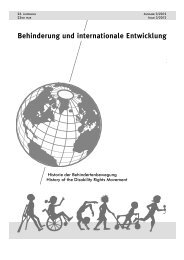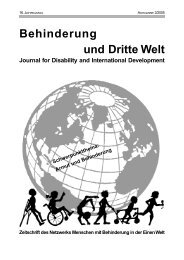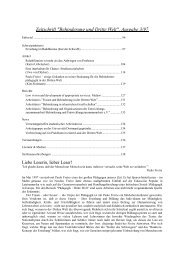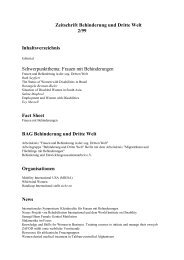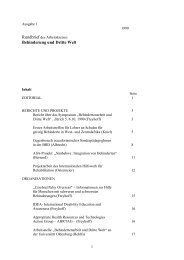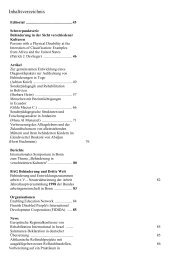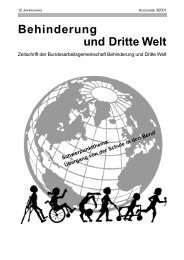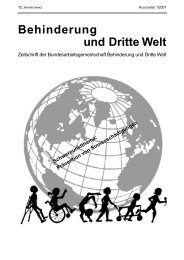Disaster and Disability in Bangladesh - Behinderung und Dritte Welt
Disaster and Disability in Bangladesh - Behinderung und Dritte Welt
Disaster and Disability in Bangladesh - Behinderung und Dritte Welt
Create successful ePaper yourself
Turn your PDF publications into a flip-book with our unique Google optimized e-Paper software.
A RTIKELthe patterns of families <strong>in</strong> newly emerg<strong>in</strong>geconomies (especially urban areas), reta<strong>in</strong><strong>in</strong>gstrong cultures of relatedness <strong>and</strong> community <strong>in</strong>a way blend<strong>in</strong>g elements of both <strong>in</strong>dividualism<strong>and</strong> collectivism. F<strong>in</strong>ally, the stronghold of resistantcultural beliefs <strong>and</strong> ideologies over people’sperceptions, attitudes <strong>and</strong> behaviours, arealso a critical factor <strong>in</strong> the debate, s<strong>in</strong>ce thesewill not be changed through legislation alone.Instead, they cont<strong>in</strong>ue to coexist <strong>and</strong> conditionthe applicability <strong>and</strong> possible outcomes of therights language alongside the nuances, opportunities<strong>and</strong> limitations offered by the social,economic, <strong>and</strong> political environment at themost micro levels.Social Capital, the L<strong>in</strong>kages <strong>and</strong> Access toOther AssetsThe second reason for the major attention paidto social capital <strong>in</strong> development has h<strong>in</strong>ged onits presumed ability to provide access to otherassets, suggest<strong>in</strong>g that social capital is not onlyan important asset <strong>in</strong> times of crisis, but aboveall may be called upon to lead to other materialga<strong>in</strong>s (<strong>in</strong>clud<strong>in</strong>g other sources of capital). Thevalue of social capital is also enhanced whencomb<strong>in</strong>ed with other types of capital. Burt(1997: 359) for example, highlights how socialcapital complements human capital 2 , stat<strong>in</strong>gthat the returns to <strong>in</strong>telligence depend on <strong>and</strong>are also cont<strong>in</strong>gent on where a person st<strong>and</strong>s<strong>in</strong> the social structure of a market or hierarchy:“while human capital refers to <strong>in</strong>dividual ability,social capital refers to opportunity.” This hasrelevance to disability, especially s<strong>in</strong>ce traditionallythe only <strong>in</strong>terventions <strong>in</strong> the majorityworld, have often been limited to prevention,rehabilitation, <strong>and</strong> occasionally skills-tra<strong>in</strong><strong>in</strong>g,<strong>and</strong>/or special <strong>and</strong> segregated education withoutaddress<strong>in</strong>g the social element, <strong>and</strong> the <strong>in</strong>fluenceof this on the success or otherwise ofthese <strong>in</strong>itiatives with disabled people. For example,while education <strong>and</strong> skills tra<strong>in</strong><strong>in</strong>g are<strong>in</strong>tr<strong>in</strong>sically valuable <strong>and</strong> can possibly lead toemployment (amongst other benefits), this taskbecomes <strong>in</strong>creas<strong>in</strong>gly difficult to achieve withoutconsider<strong>in</strong>g social relationships <strong>in</strong> sett<strong>in</strong>gstypified by disproportionate employment <strong>in</strong> the<strong>in</strong>formal sector (especially <strong>in</strong> rural areas), <strong>and</strong>where such opportunities are generally soughtthrough <strong>in</strong>formal contacts, relationships <strong>and</strong>word of mouth as opposed to more formalmeans (e.g. job adverts <strong>in</strong> newspapers).In a development sector characterised byshr<strong>in</strong>k<strong>in</strong>g f<strong>und</strong>s (associated with the neoliberalcost cutt<strong>in</strong>g advocated by the World Bank <strong>and</strong>IMF), facilitat<strong>in</strong>g membership <strong>in</strong> networks orbroader structures became an attractive communitybased strategy aid<strong>in</strong>g access to othertypes of capital that otherwise would not bepossible, such as education <strong>and</strong> health, employment,<strong>and</strong> <strong>in</strong>come among others. The valueof social capital for example has been emphasisedas a critical factor <strong>in</strong> the emergent popularityof micro-credit schemes such as thewidely acclaimed Grameen Bank model. In thiscase, social capital generates one or more ofthree externalities: facilitates <strong>in</strong>formation transmissionabout the behaviour of others (reducesthe problem of opportunism); facilitates thetransmission of knowledge about markets (reducesmarket failures <strong>in</strong> <strong>in</strong>formation); <strong>and</strong> f<strong>in</strong>allyreduces the problem of free-rid<strong>in</strong>g <strong>and</strong> sofacilitates collective action (Collier 1998). Socialcapital therefore reduces transaction costs (thecosts of <strong>in</strong>formation, monitor<strong>in</strong>g <strong>and</strong> enforcementof contract terms) <strong>and</strong> enables a creditmarket to develop. Access to credit (from bothformal <strong>and</strong> <strong>in</strong>formal sources) rema<strong>in</strong>s especiallyproblematic for disabled people, s<strong>in</strong>ce they areoften disproportionately unemployed or <strong>und</strong>eremployed,lack sav<strong>in</strong>gs, <strong>and</strong> collateral (<strong>and</strong>have limited self-employment possibilities) <strong>and</strong>subject to the perception that they are noncreditworthy<strong>and</strong>/or unproductive citizens, to besupported solely through charity. In spite ofthese barriers, disabled people rema<strong>in</strong> marg<strong>in</strong>alisedfrom ma<strong>in</strong>stream credit programmesoffered by development organisations, aga<strong>in</strong>confront<strong>in</strong>g multiple problems to access <strong>in</strong>clud<strong>in</strong>g:attitud<strong>in</strong>al barriers, <strong>in</strong>sufficient start upcapital (symptomatic of profo<strong>und</strong> poverty) <strong>and</strong><strong>in</strong>ability to satisfy programme requirementsamong others (see Cramm <strong>and</strong> F<strong>in</strong>kenflugel2008).It is at this po<strong>in</strong>t that it is important to analysewhat types of relationships lead to benefits,s<strong>in</strong>ce it is an <strong>in</strong>accurate assertion to suggestthat all relationships are a useful portal to alltypes of assets. Perhaps a useful po<strong>in</strong>t of departureis that while families <strong>and</strong> other poor peopleare often the only source of support forpoor disabled people, there is a limit to whatthey can obta<strong>in</strong> by mak<strong>in</strong>g dem<strong>and</strong>s on eachother <strong>and</strong> their often limited resources. Indeed,high levels of bond<strong>in</strong>g social capital amongpoor people do not necessarily lead to economicor other benefits, not only because ofpoor people’s scant assets, but above all becauseoften they are detached from organisedgroup<strong>in</strong>gs or lack contact with other groups(e.g. the gender movement) that may allowthem to coalesce <strong>and</strong> move ahead by augment<strong>in</strong>gpolitical, social <strong>and</strong> economic opportunities,put pressure on the state, <strong>and</strong> to challenge thestructural causes of poverty <strong>and</strong> social disad-Zeitschrift Beh<strong>in</strong>derung <strong>und</strong> <strong>Dritte</strong> <strong>Welt</strong> 1/20109



